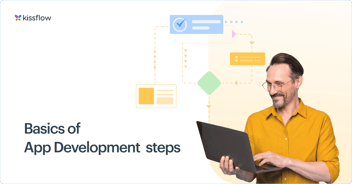
- >
- Application development platform>
- Application development lifecycle
Application Development Lifecycle: Phases and Steps Explained
Team Kissflow
Updated on 20 Jun 2025 • 7 min read
If you've ever used a great app, you probably wondered how it was created and how someone's brilliant idea became a full-fledged app. Since they are no longer just high-class tools for tech-focused sectors, apps have become necessary for every business, whether it maintains a strong online presence or not. They strengthen business operations, support marketing strategies, and increase customer retention.
Multiple factors often influence the steps in application development, including the specificity of app requirements, project size, developer's expertise level, future app changes, and the project deadline. While there is no one right approach to application building, development teams typically adopt common application development stages to make up their application development cycle.
Efficient app development methodology is a systematic process that helps you know what to expect, set the right expectations for the development team, and minimize errors. It helps organizations prepare for eventualities, create top-notch apps within their budget, and optimize them continuously.
If you plan to develop a successful app and meet users' ever-changing needs, our complete application development life cycle will provide some basic principles and set you on your way.
For a comprehensive overview of application development, explore our detailed guide: What is Application Development? A Detailed Guide to 2025.
What is an application development life cycle?
The application development lifecycle (ADLC) is a well-structured set of steps outlining app planning, creation, testing, deploying, and maintenance. As a development approach, it helps developers complete the application development stages effectively, at the lowest cost, and in the shortest time possible, to produce high-quality apps.
Application development steps can vary depending on current trends in application development, specific app requirements, such as building an AI app, your type of business, and clients. Given their ever-changing requirements, it ensures apps meet expectations and delivers a superior experience that exceeds customer expectations and demands.
Why is the application development life cycle important?
The advantages of application development lifecycle is that
-
It provides information on the ins and outs of application development, which helps organizations gauge the development timeline and ensure all requirements are clear, realistic, and met by specific deadlines.
-
The steps in application development give team leaders a bigger picture of app development, which boosts project planning and scheduling.
-
The application development cycle makes tracking and controlling projects easier so organizations can schedule app releases and keep their internal or external clients happy.
-
The standardized development framework defines activities and deliverables on all aspects of the life cycle, which increases visibility to all stakeholders involved in
-
Adherence to the development cycle minimizes the project costs and risks associated with alternative production methods.
-
Estimating project timelines addresses the typical pitfalls of app development projects and may increase the speed of development
In Forrester’s Priorities Survey, 2024, 64% [1] of business and technology professionals said that bringing more development in-house would be a high or critical priority for their IT organization over the next 12 months.
"As they mature, AppGen platforms will compress and blur the steps and roles of the software development lifecycle, democratize development further and faster, enable real-time collaboration to design and deliver applications, enable dynamic end-user experience personalization, and redefine not only the software development industry but also broad swathes of software generally."
- John Bratincevic: Principal Analyst at Forrester
Application development lifecycle explained
Following are the 6 steps in the app development lifecycle.

1. Ideation or discovery phase
During ideation, app creators collect input from all stakeholders, including industry experts, customers, developers, and salespeople, to identify available ideas or current problems. Core knowledge of the product helps developers translate the information into a detailed definition of the app requirements to create a product that meets user expectations.
Business teams or customers often have an objective, business needs, or vision of the product. While most think they know how their complete apps should look, only a developer helps them refine their ideas and resolve ambiguities.
The ideation phase identifies what needs to be built, who the end-user is, and the purpose of the product. It requires mapping out features, specifying the app's technical requirements, researching competitors, and typically translating human language into technical documentation.
2. Planning phase
The planning stage is sometimes known as the requirements-gathering stage and involves studying end-user needs, then clearly matching them to user expectations. Once gathered, requirements are classified from high-level to detailed according to the user, business, and essential system requirements.
App development planning also entails describing and documenting requirements like frequency of data backup, performance objectives, failure prevention and fault analysis, app usability, portability, accessibility, security, and recoverability. It's an incremental application development process that establishes the app's feasibility and gives the team flexibility.
Planning also includes:
-
Clearly defining the project scope and setting boundaries.
-
Performing project estimation, including costs.
-
Efficient workforce number.
-
Project deadlines.
-
Estimating procurement needs.
Businesses also allocate resources, plan capacities, schedule project timelines, identify risks, and then outline ways to soften them.
To delve deeper into effective planning strategies, read our article on Application Development Planning: Key Strategies for Success.
3. Design phase
The design stage prepares the app concept by sketching the future app and turning the app specifications into a design that showcases the app's unique look and feel. It may not require programming knowledge, especially if you use low-code/no-code platforms for app development.
App design incorporates the user interface, specific security features, app development platforms, app architecture, and how the app communicates with other systems. Creating a design prototype provides a basic idea of how the application looks and what it can do.
Feedback and suggestions from potential users, business leaders, and developers identify any iterations needed to improve the app so you can have a solid prototype with well mapped-out user flow. Failure at the design stage often results in cost overruns and may collapse the entire project.
4. Development phase
Once they fully understand product requirements, app creators build it to suit project requirements with the app development technology stack defined at the beginning of the project. Depending on the development approach your company chooses and the complexity of the app, a large team can work on different parts of the app, or one person can build the entire app.
You can create custom applications or programs with the help of low-code app development platform written out in coding language specific to the app. Where coding is needed, IT developers work alongside designers, quality assurance engineers, and a project manager, following the design blueprint and development guidelines to generate a Minimum Viable Product.
Task prioritization and estimation help developers establish how much time development may take and anticipate issues in the application development process that can delay production. While they often encounter challenges such as code bugs, they find the most optimal approaches to execute the code, review it, and make iterations for more robust, bug-free code.
5. Quality assurance and testing
Continuously testing apps ensures all the components work as expected and each part interacts well with others. The process starts once the app has been created on LCNC platforms or the coding is complete. It pinpoints defects, deficiencies, and potential risks, then fixes them. A new version of the app is produced only when all validated defects are resolved.
Testing checks whether apps meet original, defined requirements and prevents businesses from releasing low-quality apps. Testing for apps that require coding also verifies code reliability and minimizes how many bugs users encounter when using the app, thus increasing usage rate and user satisfaction.
Thorough, automated testing also evaluates the app’s compliance with customer requirements in real-world scenarios and catches any last mistakes. Higher-level testing and quality assurance, including integration, performance, security, and system testing, reduce the chances of the app failing upon release.
6. Deployment and maintenance
The application development cycle streamlines operations and shortens the time between app development and deployment. Application maintenance and continuous updating ensure your application functions optimally. Depending on the app's complexity and requirements, deployment can be manual or automated.
In a test-driven development environment, developers define a deployment workflow that involves multiple quality checks before automatically deploying the app to its end user. Once the app is released, maintenance ensures continuous app enhancements, further bug fixing, and code refinement.
Each phase in the application development lifecycle represents a critical step in creating functional, scalable, and reliable software solutions, especially in projects involving web application development.
As users interact with the app, they provide valuable feedback that enables developers to update features and improve user satisfaction and retention. App maintenance and updating also transform the apps to match the ever-changing market conditions and business requirements.
See how organizations improved efficiency in our case studies.
Establish your application development life cycle
Application development software doesn't stop after deployment; it's a continuous process. No matter how much testing an app has gone through or how stable it may be, there are always unforeseen issues likely to generate unhappy users. When your team uses the same toolset across the application development life cycle, it provides a common language that simplifies defect identification and resolution.
While every company has its application development process, the steps in application development vary a little. They help businesses set correct goals and follow best development practices to increase project transparency, track performance, and respond quickly to changes.
Application development models differ based on app requirements, project size, creation cost of applications, organization size, needs, system complexity, and skill limitation.
But adherence to a suitable cycle makes development easier and contributes to successful project completion because teams use best practices and methodologies to develop, deploy, maintain, and update apps. Discover how Kissflow Low-Code App Development platform can simplify your development process.
FAQs - Application Development Lifecycle
1. What are the main phases of the application development lifecycle?
Application development typically follows key phases: requirements gathering defines what users need; design creates the blueprint; development builds the actual code; testing ensures quality; deployment releases it to users; and maintenance keeps it running smoothly. Modern approaches often add continuous integration/deployment for faster iterations and user feedback loops throughout the process.
2. How does Agile fit into the application lifecycle?
Agile methodology forms the backbone of modern application lifecycles through iterative development cycles (sprints) that deliver working software in short timeframes. User stories capture requirements in business terms rather than technical specifications. Daily standups and sprint reviews maintain team alignment and transparency. Retrospectives drive continuous improvement of the process itself. Most importantly, Agile embraces change rather than fighting it.
3. What tools are best for managing the app development process?
Integrated development environments (IDEs) with built-in version control remain essential. Project management platforms specifically designed for development teams offer sprint planning and backlog management. Automated testing tools ensure quality without manual effort. CI/CD pipelines automate the build and deployment process. Perhaps most importantly, analytics platforms provide insights into development team productivity and application performance.
4. What are common mistakes in app development?
Inadequate user research leads to applications that solve the wrong problems. Skipping proper architecture planning creates technical debt that slows future development. Neglecting testing and quality assurance results in buggy releases that frustrate users. Overlooking security considerations creates vulnerability to data breaches. Perhaps most common is underestimating the importance of user experience design – even technically perfect applications fail if users find them difficult or unpleasant to use.
5. How can startups efficiently manage the app lifecycle?
Startups should embrace lean development methodologies with minimal documentation and maximum flexibility. Cloud-based development environments eliminate infrastructure headaches. Automated testing is critical with small teams that can't afford manual quality assurance. Third-party services for common functions (authentication, payments, etc.) accelerate development. Most importantly, continuous user feedback should drive iteration, with analytics guiding feature prioritization.
Launch your app in no time with our Kissflow work platform

Simplify your app development lifecycle with low-code.
Thanks for the download!
Related Articles













